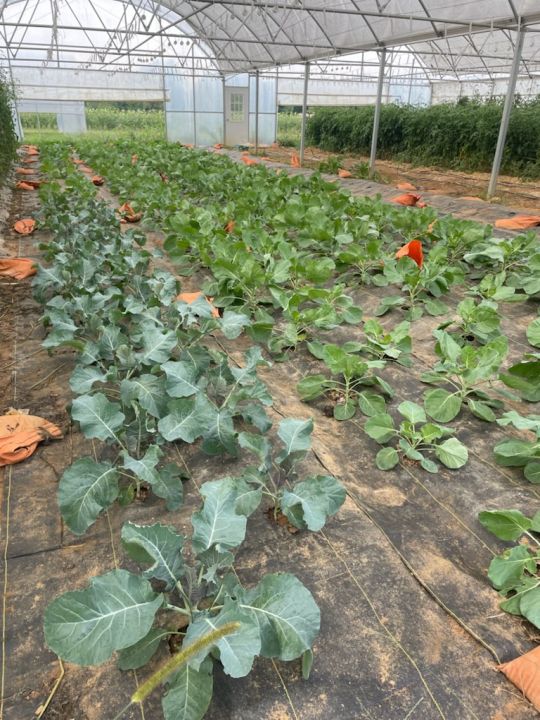One of the tasks we have been doing a lot of lately is clearing summer crops out of our high tunnels, preparing the soil, and planting fall and winter crops in their place. Today we’re taking a deep dive into the what and why of our high tunnel production.
What is a high tunnel?
A high tunnel (it can also be called a hoop house) is a structure, usually metal, that is built to have garden beds inside. It is covered in clear plastic, and is large enough for people to walk around in, sometimes large enough to accommodate a small tractor. A high tunnel is different from a greenhouse. Greenhouses are generally where young plants are grown in flats or containers either for planting into the field or to sell as plants. It is common for a greenhouse to have more climate control than a high tunnel.
Typically, crops that are grown in the high tunnel are grown in the ground. All the crops in our tunnels are grown in the the ground and in the same soil as our field grown crops, although we do typically add compost to the tunnels. There is no artificial light in our tunnels, everything is grown with sunlight. Because rain is excluded by the plastic cover, all the water these crops need to grow comes from our irrigation well.
Why grow in a high tunnel?
There are lots of reasons. For fall and winter crops, the primary reason is season extension. Our fall season is very short. We go very quickly from blazing hot to freezing overnight. Some cool weather crops need a longer season than our short fall affords. Celery and fennel can both be sensitive to freezing. But they are also slow growing crops that need a long cool season. The soil in the high tunnel stays warmer longer into late fall and winter, giving these crops enough time to mature.
Our winters are also very wet, and our soil likes to hold on to water. This can cause disease problems in certain plants, particularly onions and leeks for us. Growing them in the tunnel prevents the wet conditions that allow fungal infections to thrive, particularly by keeping the foliage dry. Diseases that can ravage field crops are often non existent in the high tunnel.
Why don’t you grow everything in a high tunnel?
If high tunnels offer so many advantages, you might be wondering why we don’t grow all our crops under protected culture. There certainly are farm operations that rely on tunnels a lot more than we do. High tunnels and even their smaller cousin the caterpillar tunnel are expensive to install and maintain. This makes high tunnel space prime real estate, reserved for crops that contribute the most to profitability.
Growing in a high tunnel can also be more labor intensive than field culture. In the high tunnels we prepare the soil by hand using a rototiller and garden rakes, and we remove plant material by hand. But using the tractor in the field to prepare the soil, spread fertilizer, shape beds, and lay plastic is much more efficient. And for some crops, there is little or no advantage to growing in the tunnel.
Even with shade cloth, working in the tunnels is hot in the summer. Although the covering on a tunnel will last many years, it is still plastic, and it will still eventually get thrown away. So we like to reserve high tunnel culture for the the crops that really need it. Ultimately how much protected culture is used on any farm is a matter of the farmer’s personal preference.
Small Shares
- lettuce mix
- butternut squash
- yellow squash or zucchini
- collards
- juliet tomato
Full shares
- butternut squash
- okra
- eggplant
- komatsuna
- kale
- slicing tomato




You must be logged in to post a comment.